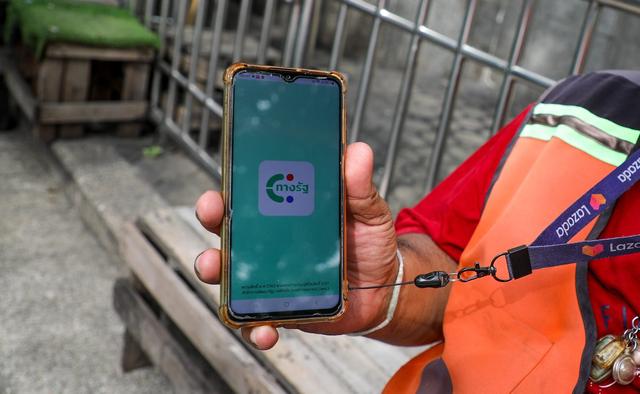Thai PBS Verify investigated a viral clip claiming a folk healer treated toothache and extracted worms from a patient’s cheek. Dentists and academics caution against believing such claims, affirming that “tooth worms” do not exist. Cases reported in the past have only involved fly larvae (maggots) found in the mouth.
Source: REEL

Fact-Checking Process
A Facebook user, “Boy Chakrapong,” posted a video with the caption: “I went to a dentist, but they didn’t extract the tooth. So I had to visit a folk healer and the result is as seen in the clip.” The clip shows a woman visiting a folk healer to treat her toothache. In the footage, the healer is seen rubbing a cotton swab on her cheek. Not long after, worms start crawling out of the cheek where the pain is. The video also has text that says, “The elders always said, ‘tooth worms.’ Well, now I’ve seen it with my own eyes.”

Under the post, a message says, “Just sharing this info with everyone. Ever since I posted the clip, many people have been asking for the location of the folk healer’s house. If you’ve ever had a toothache, you know how painful it is. Set your GPS to the …school. The healer’s house is about 1 km past it. Ask the locals around there, ‘Where’s the house of Uncle…, the one who removes tooth worms?’ The healer’s house is in Prik Subdistrict, Thung Yai District, Nakhon Si Thammarat.”
Experts warn not to believe these claims.
After the video gained widespread attention, the Facebook page “Jessada Denduangboripant,” belonging to Associate Professor Dr. Jessada Denduangboripant, also known as Ajarn Jess, a faculty member in the Department of Biology, Faculty of Science at Chulalongkorn University, shared his comments to address the issue. (Recorded linked here and here).

It says (reposted), “Don’t believe in this kind of ‘tooth worm’ treatment.” A lot of people have sent me this video asking about it, claiming it’s a “folk wisdom” way of treating tooth worms. In the video, a person with a toothache went to a house for treatment. The healer, who appeared to be an ordinary villager, mixed herbal water with cotton and applied it to the cheek near the aching tooth. After about five minutes, tiny worm-like ‘tooth worms’ emerged from the area!? It’s basically a magic trick, fooling people into believing the claim. The worms were probably hidden in the cotton swab they used, not actual ‘tooth worms’ crawling out of the aching tooth and through the cheek.
The truth is, when we have a toothache caused by cavities, it’s not because of “tooth worms,” insects, or larvae living in our mouths and eating away at our teeth. Instead, it’s due to microorganisms—bacteria—that use sugar from food debris stuck in the gaps of our teeth to produce acid. This acid erodes our tooth enamel, leading to cavities.
Earlier, I posted a warning about similar ‘tooth worms’ treatments. Back then, it involved using a “coconut shell and smoke” method to supposedly extract the worms. The trick they used was to get people to hold the tip of a device made from something like a coconut shell. Smoke was blown into the device for them to inhale and hold in their mouths.
Then, the so-called ‘tooth worms’ appeared in the coconut shell… The actual trick is that these worms were hiding in the wood used to make the cover. When exposed to smoke, they crawled out, making it seem like they came from the patient. In reality, there are no such things as ‘tooth worms.’
This kind of ‘tooth worms’ treatment, if done for free, is likely just misleading people and causing them to miss the chance for proper dental care. However, if money is charged for it, that could be considered fraud and deceiving the public! On top of that, it’s also against the law to pretend to be a licensed healthcare professional.
The poster mentioned that it’s a personal belief.
While the poster responded to the Facebook page of Jessada Denduangboripant, saying, “Let me reply to you, Ajarn. I’m the one who posted and took the video. The person who went for treatment is my girlfriend. I want to ask you, Ajarn, if someone has severe toothache that hurts up to their head and they have high blood pressure, do you think the hospital doctor would extract the tooth? I’ll answer for you, no. With the 30-baht healthcare scheme, all you get is strong paracetamol. At that time, the person with the toothache, who hadn’t slept all night due to the pain, had no other choice because they were already rejected by the hospital. They’d believe anything that could relieve the pain. The result? The pain really went away. It might be a coincidence or whatever, but it really worked.” (Recorded Link)

“I understand that superstition can’t be explained with reasons or hypotheses. It’s just like magic tricks for kids, as you said. I know you don’t believe in it because you were taught scientifically, which is understandable. But I’m just a normal person, and I won’t abandon superstition. Even if only a small percentage believe in it, if something works and makes me feel better, I’m happy to believe in it. It’s strange, though, that people who say they don’t believe in this stuff still perform religious rituals, follow Feng Shui, and have monks chant at ceremonies. These things can’t be explained with reasons or hypotheses either. Okay, lastly, I’d like to say to you, if you’re going to share your knowledge, please do it moderately. Don’t dismiss my belief as mere magic tricks. Buddhists can’t avoid these things anyway.”
What are the impacts of this false information?
The clip has been viewed a lot, with 3.1 million views and over 41,000 likes. After the content was posted, we found that many people believed it and asked about the treatment location, Comments include:
“Is there a way to send the medicine to those who live far away? I also have a severe toothache. From Sa Kaeo. Really want it.”
“Yes, this is only for those who believe. The healer helps people without asking for anything in return.”
“Does he sell the medicine?”
“Yeah, I believe it. But modern doctors say oral bacteria can’t be seen with the naked eye. There used to be this so-called ‘magical’ medicine sold near my house. The healer plugged a cotton swab into the cavity for 5–10 minutes, and then the cotton was full of worms! It really did stop the pain, though no one ever believed me when I told them. Glad I came across this again!”

Doctors say the worms in the mouth aren’t like the ones in the clip.
Thai PBS Verify spoke with Dr. Chanakan Paewpanchon, a lecturer in Restorative Dentistry at Thammasat University, who provided insight into the viral clip. He explained that, based on the video showing worms appearing to come out of the cheek, this is not how real worms in the mouth or cheek. Dr. Chanakan believed that the worms probably came from the cotton swab the man used to rub on patient’s cheek. The swab itself might have been the source, causing the worms to stick to the cheek. (Recorded Link)

In cases where worms are found in the mouth, it’s extremely rare for them to actually reside in the teeth. Most cavity cases involve tooth decay in the form of cavities or holes, but there are no worms living inside the teeth. Additionally, the symptoms of tooth decay are usually confined to the teeth themselves and do not appear on the outer cheek area.
The Causes of Tooth Decay
Tooth decay is primarily caused by the loss and insufficient reabsorption of minerals in the teeth. When we consume sugary foods, the bacteria on the surface of our teeth use the sugar to produce acid. This acid leads to the demineralization of the tooth surface, causing the surrounding area to lose essential minerals, which ultimately results in cavities.

So, when we frequently eat sweet foods, it accelerates mineral loss, outweighing the amount that is reabsorbed into the tooth structure. Over time, this ongoing loss weakens the outer tooth structure, eventually leading to cavities or tooth decay. These cavities are caused by oral bacteria—not worms burrowing into the teeth. The old belief that tooth decay was caused by ‘tooth worms’ is, in fact, a misunderstanding; it’s actually the result of bacterial activity.
There have been cases of worms found in the mouth, but they were actually fly larvae.
There is a reported case involving worms in the mouth, where a bedridden patient, unable to brush their teeth or care for themselves, experienced a buildup of food debris. This led to bacteria thriving in the mouth, which attracted flies that eventually laid eggs there, resulting in the presence of larvae.
“This kind of case has actually happened before, but it’s super rare and has absolutely nothing to do with ‘tooth worms.’”
There was actually a case in Thailand where worms were found in a patient’s mouth. This happened on May 5, 2020, and was shared by a dentist at Phra Phrom Hospital in Lan Saka, Nakhon Si Thammarat. The patient, who was bedridden and living at home, couldn’t speak and was unable to inform anyone about the situation. It turned out there were 12 fly larvae found in his mouth. (Recorded Link)
How to Maintain Good Oral Health
It is recommended to brush your teeth twice a day, in the morning and before bed. Modern toothpaste contains 1,500 ppm of fluoride, which is highly effective in preventing tooth decay. The key is to use toothpaste with fluoride and to avoid consuming sugary foods, snacks, or juices with added sugar. Frequent or prolonged consumption of these foods can significantly increase the risk of cavities. Therefore, it is best to avoid such foods if possible or limit their consumption to mealtimes to help prevent tooth decay.





